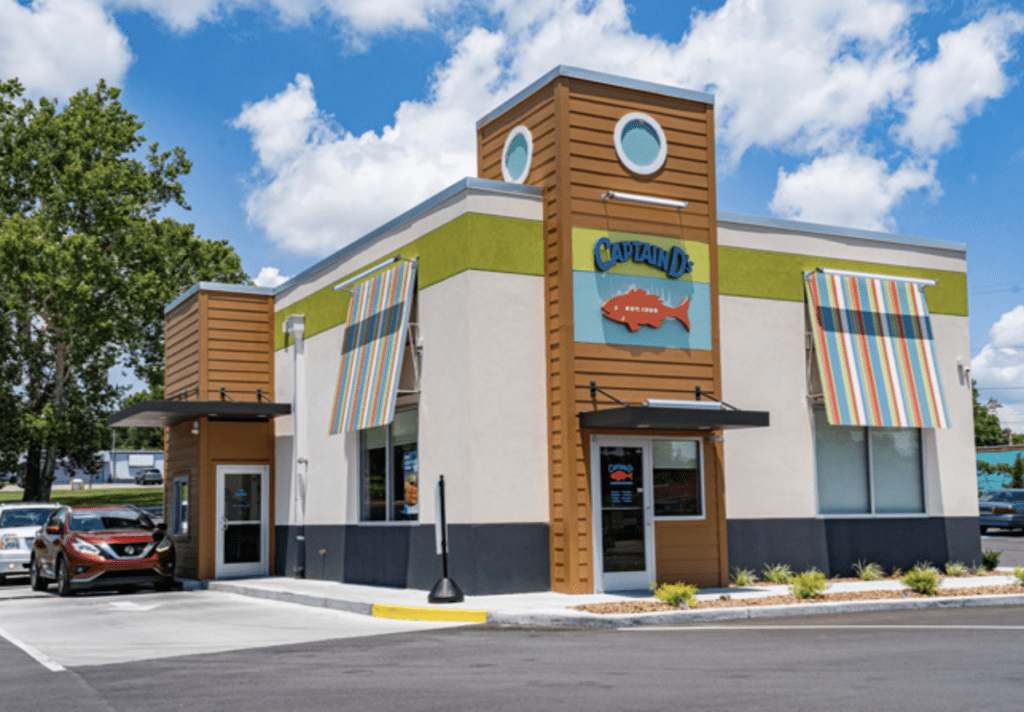Source: Restaurant Development + Design Magazine
Finding restaurant spaces can be difficult, especially given increasing interest rates and the rising real estate market. It can often be less expensive, and faster, to convert a space to hold a restaurant than to opt for ground-up construction.
Captain D’s has converted most types of buildings, from a Starbucks to an old barbecue joint, stopping short only of former banks because the vault can pose some challenges.
It’s also typically faster to convert a building, rather than build a new one “because you’re working within a shell,” says Larry Jones, vice president of construction for the Nashville, Tenn.-based brand.
“Conversions of former businesses into your brand can be a quick and cost-effective way to add unit count and repurpose a building that still has useful life,” he says. “Municipalities are generally favorable to rehabbing a closed business and may even expedite permitting compared to a ground-up build. Conversions can be a successful option in your expansion efforts.”
Jones shares his best practices for converting spaces into new restaurants.

1. Determine whether it’s worth it
The top priority for Captain D’s is good ingress and egress, and the ability to have a drive-thru, says Jones. Plenty of parking is also important. If these aren’t available, the building isn’t a good choice.
2. Evaluate the building
Jones takes a thorough look at the building itself — does the structure lend itself to an easy changeover to Captain D’s trade dress and visual standards? There is some flexibility with this, “but it has to have enough recognizable trade dress so you immediately say that’s a Captain D’s,” he says.
Then he looks at the integrity of the building. If it’s early 1980s and before, there’s likely to be a lot of wear and tear and a lot of code updates with electrical and plumbing, he says. He also needs to know what a building is made from – which parts are cement, wood or steel.
Jones is also sure to check out the ventilation systems; what type of power is coming into the building — gas, electricity, both? And what will be required: Where is the available plumbing and will Captain D’s have to rip up a lot of concrete floor?
He also checks to see if walls have been added and if they’re load-bearing, He typically checks under ceiling tiles and looks at the roof structure; he looks at where drains have been placed and whether things have been moved.
“We look at each building as an individual site and it doesn’t even need to have been a restaurant, though it’s most common that it has,” Jones says.
3. Verify the floor plan
Inside, he looks at the floor plan. “Does it lend itself to how we deploy our equipment and if not, how hard is it to move walls?” asks Jones. “Does it have existing hood ventilation and if so, is it sufficient for our needs? If it doesn’t, what type of wall structure does it have? Is it fireproofed or do I need to take out a wall to add that?”
Different layouts are not a deal-ender because Captain D’s has several deployments for both the front of the house and the back. “Some might not be perfect but they’re perfect enough for that environment,” says Jones.
4. Be ready to learn
Because he’s converted so many buildings, Jones has found he learns along the way. “You learn how your competitor, or the operator, solved problems, and it’s been very informative. I’ll see how they managed workflow or solved a particular problem and I’ll learn from that. If you’re just punching out your own cookie every time, you don’t necessarily solve and learn.”
5. Recognize your deal-breakers
Captain D’s will not consider a converted space if it’s going to cost more to get it up to snuff than a brand-new build would cost. Most says Jones, “are just light cosmetic applications to the building, not counting equipment and furnishings.”
Most conversions cost $100,000 or less though some go as high as $750,000. However, if Tango Analytics and the Captain D’s team indicate it’s going to be a really good site, it may splurge on it. Ground-up construction for Captain D’s currently costs around $1.2 million.
In one location, Jones says, there was too much he’d have to overcome to bring it up to current codes, demolish some areas and deal with things like asbestos and wear and tear. “So I had to tell the team that unless you scrape this and start over it’s not viable and that it’s going to put us outside what we’re willing to spend.”
If multiple restaurants have failed in a location you’re considering, that can be a sign to stay away, says Jones. “Or if it’s a small community [the local population] can just decide that location is not good — maybe it’s been a couple of bad things so they think nothing good’s going to be there.” However, Captain D’s does feel its brand is a bit of an outlier “because we say we’re a category of one in the quick casual seafood arena.”
6. Be open to change
Captain D’s seeks to employ a drive-thru at its restaurants but the landscape has changed since COVID due to the growth of third-party delivery, which, says Jones, “can offset a drive-thru.” So Captain D’s is now considering inline strip centers, which opens up a lot more spaces to convert. But for these, the brand needs drive aisles, he says, “the ability for people to park easily and exit and enter. We’ve noticed the difficulty to get onto and off the site can affect the desire to return.”
